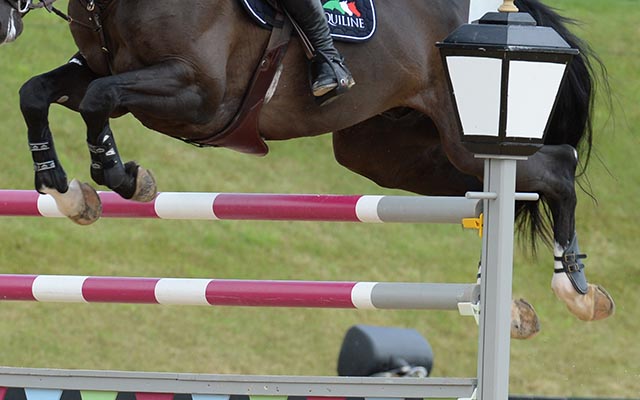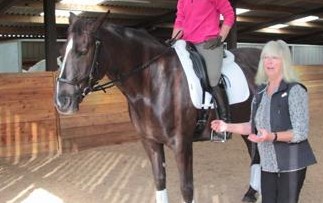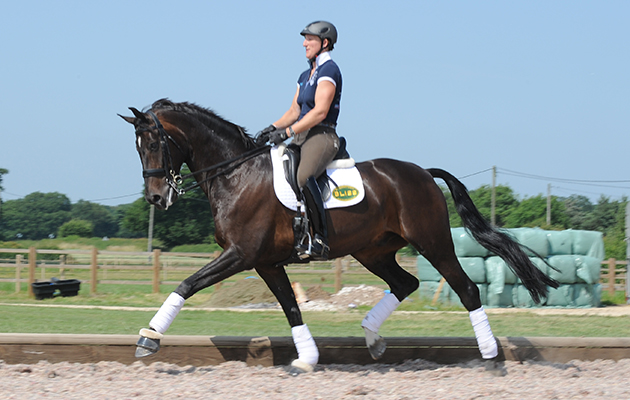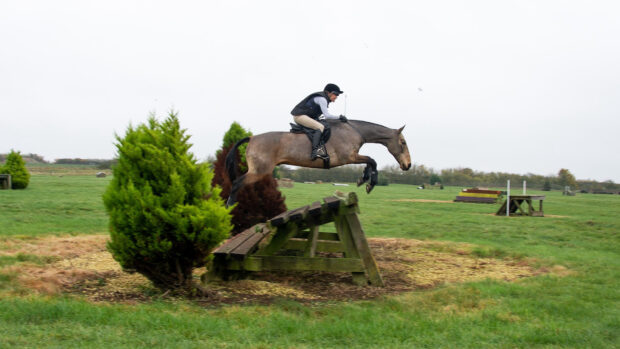In her book 'Breathe Life Into Your Riding', Jenny Rolfe explains her 'breath energy' techniques and how they could help your riding. Watch her in action with Eva, a warmblood mare who has recently been introduced to this approach
Several years ago if someone had told me that they could gain response from a horse by becoming aware of breathing and levels of energy, I may have been extremely sceptical.
Without much thought, I was placing my human limitations on the mind and sensitivity of the horse. I have discovered that when the rider enhances a natural pattern of deeper core breathing together with more grounded energy, it will instigate an immediate and profound response from the horse. If the rider is disciplined and consistent with this practice, it will not only enhance general health and well being but open the doors for further exploration.
When you sit on the horse you connect through your seat, but have you ever thought of connecting with your horse through your breathing? When you sit on the back of a horse, you connect with his spine and his central nervous system. The wave of a breath creates a powerful connection with the highly sensitive nature of the horse.
We understand that herd language is an awareness of body language but it goes much deeper as horses initially respond to any subtle changes in energy and breathing.
The power of breathing has a direct affect on how the human and equine body can function.
Shallow, tense breathing results in tightness of muscles and limbs which restricts both mobility and co-ordination. The rider has so much to focus on, that if his body is restricted by shallow breathing, he cannot fulfil his aspirations of relaxed harmonious riding.
Once we begin to master our own state of mind, tension and balance, we will be in a place where we can more easily be taught, by both a trainer and the horse. We will be able to respond more effectively with fluidity within our body and greater focus of our mind.
If we inhale and exhale, using lateral breathing, thus using correct abdominal muscles, then a core of stability will be created. This will help us to locate our correct centre of balance and gravity.
Continued below…

10 tips to banish competition riding nerves
Do you suffer from competition riding nerves? Find out how to take control and use nerves to improve your performance
Harmony for the rider
If riders want to ride in harmony in their horses what do they need to do?
Preparation is the key to build on self awareness. With this in mind I have developed a TOP TO TOE for the rider:
Begin with a basic position which will enhance stability, balance and poise. These techniques are similar to the ancient wisdoms of the east, such as Chi Gong and Tai Chi.
- Stand quietly and cultivate the feeling of breathing, into the space around you. Now take a slow deep outward sigh and begin your focus on steady breathing, beginning within your core.
- Expand your abdomen with your inhalation , breathe into your body — as if filling up a glass with water – from the core upwards.
- Exhale deeply down through your upper body and spine, releasing through your core.
- Your feet should be parallel, about shoulder width apart — have a feeling of connecting through your legs and feet, into the core of the earth — ‘feeling truly grounded’.
- Relax down through your legs, into released knees and ankles as if you are skiing down a bumpy slope .
- Grow taller and expand your posture allowing your head to come slightly forward and upwards. Do not tighten the back of the neck but allow it to lengthen, keep your jaw relaxed.
- Cultivate the feeling that your head is balanced in lightness, floating above the shoulders, as a balloon above your body. Lengthening of the neck helps to release the shoulders and arms.
- Soften the muscles around your eyes.
- Relax the facial muscles and release the jaw. Allow the back of your neck to lengthen gently. Relax your jaw and soften your lips.
- Keep a relaxed feel in your sternum whilst breathing. Expand the chest, not by tightening the sternum and hollowing your back, but widen through the shoulder blades and ribcage , breathing wide and full, into your spine.
- Take a deep outward sigh and allow the breath to ripple through your torso down into your core and through your legs and feet.
You should start to feel more relaxed and grounded. Focus on your body awareness from your head down through to your toes.
Work under saddle
Once in the saddle, it is worth taking a few moments to check our posture from ‘Top to toe’ then take a very deep outward sigh, rippling down your upper torso into your core to release any tension. This will just relax your body releasing tension through your muscles and joints. Allow the next inward breath, just to happen, in a natural way. Remember when you give a deep sigh it is just a gentle release of energy through your body. This is a different feel to the outward breath which directs the stronger energy, from the core towards the horse, which will instigate his movement.
Breathe into walk
When you feel calm and focused top to toe, take up an allowing contact with the reins, then inhale followed by a more vigorous outward breathe. The exhalation will ripple down your spine releasing your core which encourages the horse to move forwards. This movement for the rider is similar to sitting on a swing and pushing it forwards and upwards, but it is much more subtle. If your horse does not respond, use your legs once and if needed back up with a tap of the whip on your own leg. Very quickly the horse will tune into this sequence of aids and respond from your breath alone. When the horse is walking forwards, continue breathing naturally and rhythmically with every stride. Imagine you are jogging and supporting your running with steady inhalation and exhalation.
Breathe into the halt
When asking the horse to halt, your deeper inhalation will lengthen and strengthen your spine, creating stability and acting as a half halt. As the horse responds, increase the inward breath, close your fingers on the reins and ask him to halt. Once the horse is standing still, release the pressure of your fingers on the reins, so he can stand immobile in a good self-carriage. Gain his focus with your steady core-breathing. He should be calm and still, yet ready to move on your next deeper, energizing exhalation. If the horse is allowed to stand, with only a light contact with the reins, his forward movement will be in lightness and not bearing down.
Transitions — from walk to trot
Prepare by walking forwards with a good energetic rhythm. Before you trot forwards ensure the horse is relaxed into a steady contact created from the propulsion of the hind limbs, enhanced by his attentive calm mind.
Try to breathe steadily and naturally with awareness of expanding your core on the inward breath and releasing gently through your core, on exhalation. Take a deeper inward breath to prepare to trot. This will re-balance and further engage the movement and gain his attention for a change in gait. Allow a deeper breath outwards and feel the energy ripple down through your spine, this will release the core and mobilise the seat.
If the horse does not respond then use your legs, just once and re-enforce with a tap of the whip, if needed. Focus on regular natural breathing and use the deeper outward breath to instigate more energy.
Tap once with your legs if the horse is not attentive to your energising breath. The horse will soon tune into your breathing alone which will enable your legs just to hang in a relaxed way down either side of the horse’s rib cage. In this way your natural balance will not be continually disrupted.
If your horse tries to pull and get too strong in your hand, re-balance with a focus on a deep inhalation and if necessary close your fingers on the reins. Your more intense inward breath will expand and strengthen your seat and core.
This will give stability to the horse who will feel this momentary resistance to his forward movement. He will then re-balance and with a more allowing contact from your hand and fingers, you can encourage him to move forward with lightness. When you take the deeper inward breath, it not only lengthens and strengthens your spine but you will feel the tightness through your upper leg and thigh.
The horse is extremely sensitive to any change of balance or restriction from the rider. The feeling of restraint which is a momentary check from the rider, will probably be sufficient to steady the horse.
The horse will quickly listen to core breathing as the first aid when asking for any change, whether in pace or direction.
Techniques of breathing will energise a lazy horse or equally calm an anxious horse. Breathing awareness will enhance communication between horse and rider. This will open up a path towards harmony and lightness.
































